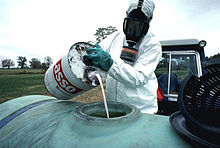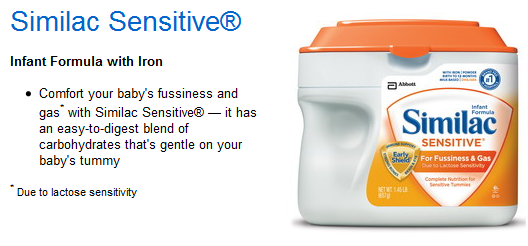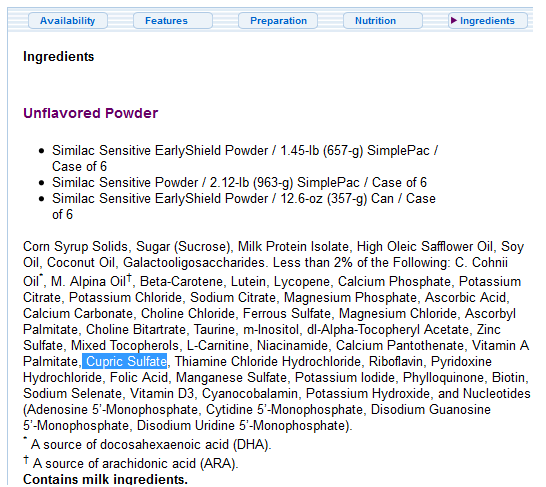Sayer Ji, Contributor
Activist Post
Why is cupric sulfate — a known herbicide, fungicide and pesticide — being used in infant formula? And why is it displayed proudly on product labels as a presumably nutritious ingredient?
Used to kill fungus, aquatic plants and roots of plants, parasitic infections in aquarium fish and snails, as well as algae and bacteria such as Escherichia coli, cupric sulfate hardly sounds fit for human consumption, much less for infants.
Indeed, infants are all too often looked at as “miniature adults” from the perspective of toxicological risk assessments, rather than what they are: disproportionately (if not exponentially) more susceptible to the adverse effects of environmental exposures. Instead of reducing or altogether eliminating avoidable infant chemical exposures (the precautionary principle), the chemical industry-friendly focus is always on determining “an acceptable level of harm” – as if there were such at thing!
It boggles the imagination how cupric sulfate ended up in infant formula, as well as scores of other consumer health products, such as Centrum and One-A-Day vitamins?
After all, it is classified, according to the Dangerous Substance Directive (one of the main European Union laws concerning chemical safety), as “Harmful (Xn), Irritant (Xi) and Dangerous for the environment (N).”
Moreover, the U.S. Environmental Protection Agency (EPA) requires that the warning signal “DANGER” appear on the labels of all copper sulfate end-products containing 99% active ingredient in crystalline form.
The Material Safety Data Sheet for Cupric Sulfate clearly states, in ‘Section 3: Hazards Identification,” that it has the following adverse health effects:
Potential Acute Health Effects: Hazardous in case of skin contact (irritant), of eye contact (irritant), of ingestion, of inhalation.
Potential Chronic Health Effects: CARCINOGENIC EFFECTS: Not available. MUTAGENIC EFFECTS: Mutagenic for mammalian somatic cells. TERATROGENIC EFFECTS: Not available. DEVELOPMENT TOXICITY: Not available. The substance may be toxic to kidneys, liver. Repeated or prolonged exposure to the substance can produce target organs damage.
In ‘Section 7: Handling and Storage” the following precautions must be taken:
Do not ingest. Do not breathe dust. Wear suitable protective clothing. In case of insufficient ventilation, wear suitable respiratory equipment. If ingested, seek medical advice immediately and show t he container or the label. Avoid contact with skin and eyes. Keep away from incompatibles such as metals, alkalis.
Cleary we have a problem here. Cupric sulfate is used in most mass market infant formulas. Even Similac’s “sensitive” formula contains the ingredient:
Could this be one reason why infant formula has been linked to over 50 adverse health effects, both short and long term, in infants given it in place of breast milk? The common explanation/claim is that infant formula isn’t intrinsically harmful, rather, breast milk and breastfeeding is just healthier. I believe this perspective in untenable, given the problems with cupric sulfate, and dozens of other questionable ingredients being used in these products, such as petroleum-derived and chirally inverted dl-alpha tocopherol (synthetic vitamin E), zinc sulfate, sodium selenate, manganese sulfate, etc.
For additional research on the inherent problems associated with the use of chemicals in infant formula, take a look at our evaluation of another Similac product.
Or, take a look at the “Organic” infant formula by Earth’s Best:, which is surprisingly not that much better.
Related Article
Chemicals Used As “Nutrients” In “USDA Organic” Infant Formula
Cupric Sulfate – Pesticide Information Profile
Cupric Sulfate – Toxicology Research on GreenMedInfo.com
Blog: Infant Formula For Disaster
Blog: Is Your Multivitamin Toxic?
This article first appeared at GreenMedInfo. Please visit to access their vast database of articles and the latest information in natural health.
linkwithin_text=’Related Articles:’





Be the first to comment on "Why Is Pesticide Used As An Ingredient In Infant Formula?"